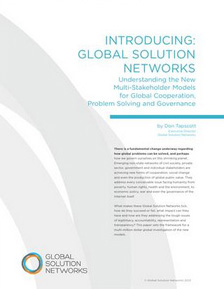 The growing problems of the world — from climate change, conflict, poverty, water scarcity, infectious disease to economic stagnation — are not too hard to solve. Rather progress is stalled because our model is wrong. The good news is that traditional state based institutions such as the UN, the International Monetary Fund or the G8 summits are being supplemented and even eclipsed by non-state networks of civil society, the private sector, government and individual stakeholders.
The growing problems of the world — from climate change, conflict, poverty, water scarcity, infectious disease to economic stagnation — are not too hard to solve. Rather progress is stalled because our model is wrong. The good news is that traditional state based institutions such as the UN, the International Monetary Fund or the G8 summits are being supplemented and even eclipsed by non-state networks of civil society, the private sector, government and individual stakeholders.
Call them Global Solution Networks. Until now, little has been done to evaluate what makes these networks tick, how they succeed or fail, what impact they have and how they address the tough issues of legitimacy, accountability, representation and transparency. Tapscott shares some initial conclusions from a multi-million dollar study he is leading about how new patterns of connection can fulfill their enormous potential in fixing a broken world.





